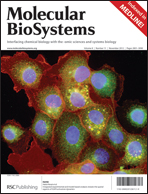Predicting most probable conformations of a given peptide sequence in the random coil state
Abstract
In this work, we present a computational scheme for finding high probability conformations of peptides. The scheme calculates the probability of a given conformation of the given peptide sequence using the probability distribution of torsion states. Dependence of the states of a residue on the states of its first neighbors along the chain is considered. Prior probabilities of torsion states are obtained from a coil library. Posterior probabilities are calculated by the matrix multiplication Rotational Isomeric States Model of polymer theory. The conformation of a peptide with highest probability is determined by using a hidden Markov model Viterbi algorithm. First, the probability distribution of the torsion states of the residues is obtained. Using the highest probability torsion state, one can generate, step by step, states with lower probabilities. To validate the method, the highest probability state of residues in a given sequence is calculated and compared with probabilities obtained from the Coil Databank. Predictions based on the method are 32% better than predictions based on the most probable states of residues. The ensemble of “n” high probability conformations of a given protein is also determined using the Viterbi algorithm with multistep backtracking.


 Please wait while we load your content...
Please wait while we load your content...